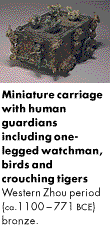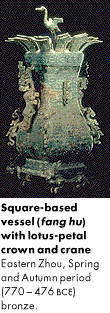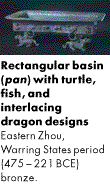 |
 |
 |
 |
 |
 |
 |

This eighth-century BCE miniature box on wheels is
ingeniously designed with fifteen moving parts: six turning
wheels, four hinged openings, a sliding door bolt, and four
pivoting birds. The one-legged doorkeeper might have been
chosen specifically for his handicap: he could not easily
run away with the treasures he was supposed to be guarding.
The clever design, movable parts, and miniature size
suggest that this was a personal luxury-a toy or a
container for valuable memorabilia. |
 |
 |
 |
 |
This bravura epitome of the
bronze caster's art was probably made in the state of Chu,
which by the seventh-sixth century BCE had emerged as the
most powerful ruling house south of the Yangzi River. The
standard Zhou motif of serpentine dragons in relief,
marshalled in strict symmetry, cloaks the surface of the
vessel. Southern taste appears in the elaborate appendages
composed of fantastic three-dimensional creatures,
half-dragon and half-feline, with many-branched,
trumpet-shaped, or openwork horns. Lotus petals rising form
the lid echo the openwork and centered among them a
realistically modeled crane raises its wings for flight. To
make this vessel, bronze casters combined standard
section-mold casting for the body with the less frequently
used lost-wax method for the appendages. Wax, being soft
and pliable, can be made into a model of enormous
intricacy. When the model is encased in clay and fired, the
wax melts away through vents in the clay, leaving a ceramic
mold whose cavity exactly duplicates the model. The
appendage made in this lost-wax mold is then fitted into
the section-mold in which the body is to be cast. |
 |
 |
 |
 |
By the end of the first
millennium bce a myriad of new bronze types, such as this
rectangular basin, were made in increasing numbers to
satisfy the growing demand for personal items for both
daily use and display. The pattern of interlaced serpents
on the interior and exterior of the basin was achieved by
making repeated clay negatives from a single master unit to
create identical repeated patterns on the basin. This
technique, which answered the need for more rapid and
efficient manufacturing methods, is believed to have been
used by bronze casters working at the foundry at Houma,
Shanxi Province, where thousands of these decorated clay
molds were recovered. Also found at the Houma foundry were
molds for the highly realistic tigers that support the
basin. Taotie, awesome zoomorphic masks on the
ritual vessels of the earlier Bronze Age, reappear on the
basin as mere decorative holders for the vessel's ring
handles. |
 |



